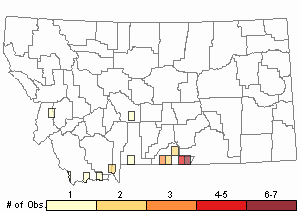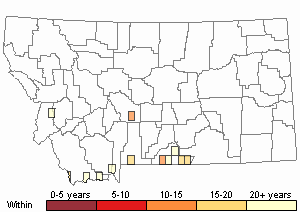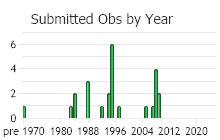View in other NatureServe Network Field Guides
NatureServe
Montana
Utah
Wyoming
Idaho
Wisconsin
British Columbia
South Carolina
Yukon
California
New York
Parrot-head Indian Paintbrush - Castilleja pilosa var. longispica
Other Names:
Castilleja longispica
Native Species
Global Rank:
G4G5T4
State Rank:
S3S4
(see State Rank Reason below)
C-value:
Agency Status
USFWS:
USFS:
BLM:
External Links
State Rank Reason (see State Rank above)
Castilleja pilosa var. longispica occurs in southwest to south-central Montana, which represents the eastern edge of its range. It is fairly common in parts of its Montana range, though some observations may be mis-identified. It occurs in common habitats such as grassland, sagebrush steppe, and woodlands and threats have not been identified. Current information on locations, population sizes, and threats is needed.
- Details on Status Ranking and Review
Range Extent
ScoreF - 20,000-200,000 sq km (~8,000-80,000 sq mi)
Commentat least 26,490 square kilometers
Area of Occupancy
ScoreE - 26-125 4-km2 grid cells
CommentPlant occurs in 35 of the 30,590 4x4 square-kilometer grid cells that cover Montana.
Number of Populations
ScoreC - 21 - 80
Comment55 observations
Environmental Specificity
ScoreC - Moderate. Generalist or community with some key requirements scarce
Threats
ScoreD - Low
General Description
PLANTS: A short, hemi-parasitic, herbaceous, perennial forb that arises from a branched caudex. Plants are many-stemmed, generally decumbent at their bases, erect upwards, and 10-30 cm tall; stems occasionally branch above. Foliage is covered with short to long and soft hairs which often point downwards; hairs are seldom matted or tangled.
LEAVES: Arranged alternately on the stem. Alternately arranged, narrow, the lower leaves tending to be entire, while the mid- to upper-leaves often have two pairs of long narrow lateral lobes.
INFLORESCENCE: A dense, terminal, bracteate spike. Each flower is subtended by a broad leaf-like bract with yellowish or sometimes purplish tips and 1-3 pairs of slender lobes. The tubular calyx, 10-20 mm long, surrounds the corolla and is cleft into 4 equal, pointed lobes. The yellow, tubular corolla, 15-20 mm long, tapers to a short hood (galea) above and 3 small lobes below. Although the flowers are not completely hidden, the inflorescence takes its color from the bracts rather than the flowers.
Taxonomy
Castilleja pilosa var. longispica is treated at the species level as Castilleja longispica in Manual of Montana Vascular Plants (Lesica et al. 2012). The Intermountain Flora (1984) treated the plant at the variety level. In deference to Noel Holmgren the Flora of North America-Volume 17 (2019) treats the plant at the variety level though species recognition may be justified (Mark Egger personal communication).
Sources: Giblin et al. [eds.] 2018; Lesica et al. (2012); Holmgren in Intermountain Flora 1984.
Phenology
Flowering in June, July and early August.
Diagnostic Characteristics
Castilleja is a difficult genus because hybridization and allopolyploid speciation (containment of multiple sets of chromosomes that are derived from different species) fuzz a species’ characteristics (Giblin et al. [eds.] 2018).
To identify
Castilleja species, it is important to (Giblin et al. [eds.] 2018):
* note colors of the bract, calyx, and corolla while in the field, and
* press many bracts, calyces, and corollas separately to show their shapes.
Parrot-head Indian Paintbrush -
Castilleja pilosa var.
longispica, native:
* Bracts are green to yellow or purplish.
* Upper third of the stem with green, lobed leaves.
* Lobes of the calyx are cleft to about the same length.
* Inflorescence with puberulent to sparsely villous hairs.
* Montana plants occur in montane to subalpine zones.
Pallid Indian Paintbrush -
Castilleja pallescens, native:
* Bracts are green to yellow or purple-tipped. Calyx is yellow.
* Upper third of the stem with green, often with linear lobed leaves, or at least the central lobe is linear.
* Lobes of the calyx are cleft more deeply in front and back than compared to the sides.
* Ultimate calyx lobes are acute to acuminate.
* Galea is 2-4 mm. Lower corolla lip is 2-3 mm. Thus, lower lip is more than half the length of the galea.
* Inflorescence with puberulent to pilose hairs.
* Montana plants occur in valleys to alpine zones.
Snow Indian Paintbrush -
Castilleja nivea, native:
* Bracts are yellow to purple-tipped and woolly-villous.
* Upper third of the stem with green, lobed leaves.
* Lobes of the calyx are cleft to about the same length.
* Inflorescence villous-tomentose.
* Montana plants occur in the alpine zone (turf and fellfields).
Species Range
Montana Range
Range Descriptions

 Native
Native
Range Comments
Oregon to Montana south to California and Wyoming (Lesica et al. 2012).
Observations in Montana Natural Heritage Program Database
Number of Observations: 27
(Click on the following maps and charts to see full sized version)
Map Help and Descriptions
Relative Density

Recency



 (Observations spanning multiple months or years are excluded from time charts)
(Observations spanning multiple months or years are excluded from time charts)
Habitat
Sagebrush steppe, grasslands, and woodlands in the montane zones of Montana (Lesica et al. 2012).
Ecology
POLLINATORS The following animal species have been reported as pollinators of this plant species or its genus where their geographic ranges overlap:
Bombus appositus,
Bombus bifarius,
Bombus fervidus,
Bombus flavifrons,
Bombus melanopygus,
Bombus sylvicola,
Bombus occidentalis, and
Bombus kirbiellus (Macior 1974, Thorp et al. 1983, Bauer 1983, Mayer et al. 2000, Wilson et al. 2010, Pyke et al. 2012, Koch et al. 2012, Miller-Struttmann and Galen 2014, Williams et al. 2014).
References
- Literature Cited AboveLegend:
 View Online Publication
View Online Publication Bauer, P.J. 1983. Bumblebee pollination relationships on the Beartooth Plateau tundra of Southern Montana. American Journal of Botany. 70(1): 134-144.
Bauer, P.J. 1983. Bumblebee pollination relationships on the Beartooth Plateau tundra of Southern Montana. American Journal of Botany. 70(1): 134-144. Cronquist, A., A.H. Holmgren, N.H. Holmgren, J.L. Reveal, and P.K. Holmgren. 1984. Intermountain Flora: Vascular Plants of the Intermountain West, U.S.A. Vol. 4, Subclass Asteridae (except Asteraceae). Bronx, NY: New York Botanical Garden. 573 pp.
Cronquist, A., A.H. Holmgren, N.H. Holmgren, J.L. Reveal, and P.K. Holmgren. 1984. Intermountain Flora: Vascular Plants of the Intermountain West, U.S.A. Vol. 4, Subclass Asteridae (except Asteraceae). Bronx, NY: New York Botanical Garden. 573 pp. Hitchcock, C.L. and A. Cronquist. 2018. Flora of the Pacific Northwest: An Illustrated Manual. Second Edition. Giblin, D.E., B.S. Legler, P.F. Zika, and R.G. Olmstead (eds). Seattle, WA: University of Washington Press in Association with Burke Museum of Natural History and Culture. 882 p.
Hitchcock, C.L. and A. Cronquist. 2018. Flora of the Pacific Northwest: An Illustrated Manual. Second Edition. Giblin, D.E., B.S. Legler, P.F. Zika, and R.G. Olmstead (eds). Seattle, WA: University of Washington Press in Association with Burke Museum of Natural History and Culture. 882 p. Koch, J., J. Strange, and P. Williams. 2012. Bumble bees of the western United States. Washington, DC: USDA Forest Service, Pollinator Partnership. 143 p.
Koch, J., J. Strange, and P. Williams. 2012. Bumble bees of the western United States. Washington, DC: USDA Forest Service, Pollinator Partnership. 143 p. Lesica, P., M.T. Lavin, and P.F. Stickney. 2012. Manual of Montana Vascular Plants. Fort Worth, TX: BRIT Press. viii + 771 p.
Lesica, P., M.T. Lavin, and P.F. Stickney. 2012. Manual of Montana Vascular Plants. Fort Worth, TX: BRIT Press. viii + 771 p. Macior, L.M. 1974. Pollination ecology of the Front Range of the Colorado Rocky Mountains. Melanderia 15: 1-59.
Macior, L.M. 1974. Pollination ecology of the Front Range of the Colorado Rocky Mountains. Melanderia 15: 1-59. Mayer, D.F., E.R. Miliczky, B.F. Finnigan, and C.A. Johnson. 2000. The bee fauna (Hymenoptera: Apoidea) of southeastern Washington. Journal of the Entomological Society of British Columbia 97: 25-31.
Mayer, D.F., E.R. Miliczky, B.F. Finnigan, and C.A. Johnson. 2000. The bee fauna (Hymenoptera: Apoidea) of southeastern Washington. Journal of the Entomological Society of British Columbia 97: 25-31. Miller-Struttmann, N.E. and C. Galen. 2014. High-altitude multi-taskers: bumble bee food plant use broadens along an altitudinal productivity gradient. Oecologia 176:1033-1045.
Miller-Struttmann, N.E. and C. Galen. 2014. High-altitude multi-taskers: bumble bee food plant use broadens along an altitudinal productivity gradient. Oecologia 176:1033-1045. Pyke, G.H., D.W. Inouye, and J.D. Thomson. 2012. Local geographic distributions of bumble bees near Crested Butte, Colorado: competition and community structure revisited. Environmental Entomology 41(6): 1332-1349.
Pyke, G.H., D.W. Inouye, and J.D. Thomson. 2012. Local geographic distributions of bumble bees near Crested Butte, Colorado: competition and community structure revisited. Environmental Entomology 41(6): 1332-1349. Thorp, R.W., D.S. Horning, and L.L. Dunning. 1983. Bumble bees and cuckoo bumble bees of California (Hymenoptera: Apidae). Bulletin of the California Insect Survey 23:1-79.
Thorp, R.W., D.S. Horning, and L.L. Dunning. 1983. Bumble bees and cuckoo bumble bees of California (Hymenoptera: Apidae). Bulletin of the California Insect Survey 23:1-79. Williams, P., R. Thorp, L. Richardson, and S. Colla. 2014. Bumble Bees of North America. Princeton, NJ: Princeton University Press. 208 p.
Williams, P., R. Thorp, L. Richardson, and S. Colla. 2014. Bumble Bees of North America. Princeton, NJ: Princeton University Press. 208 p. Wilson, J.S., L.E. Wilson, L.D. Loftis, and T. Griswold. 2010. The montane bee fauna of north central Washington, USA, with floral associations. Western North American Naturalist 70(2): 198-207.
Wilson, J.S., L.E. Wilson, L.D. Loftis, and T. Griswold. 2010. The montane bee fauna of north central Washington, USA, with floral associations. Western North American Naturalist 70(2): 198-207.
- Additional ReferencesLegend:
 View Online Publication
View Online Publication
Do you know of a citation we're missing? Culver, D.R. 1994. Floristic analysis of the Centennial Region, Montana. M.Sc. Thesis. Montana State University, Bozeman. 199 pp.
Culver, D.R. 1994. Floristic analysis of the Centennial Region, Montana. M.Sc. Thesis. Montana State University, Bozeman. 199 pp. Lesica, P. 1993. Vegetation and flora of the Line Creek Plateau area, Carbon County, Montana. Unpublished report to USDA Forest Service, Intermountain Research Station. Montana Natural Heritage Program, Helena, Montana. 30 pp.
Lesica, P. 1993. Vegetation and flora of the Line Creek Plateau area, Carbon County, Montana. Unpublished report to USDA Forest Service, Intermountain Research Station. Montana Natural Heritage Program, Helena, Montana. 30 pp. Lesica, P. 1995. Conservation status of Castilleja longispica on Custer and Gallatin National Forests, Montana. Unpublished report to the U.S.D.A. Forest Service Region One, Missoula, MT. Montana Natural Heritage Program. 44 pp. plus appendices.
Lesica, P. 1995. Conservation status of Castilleja longispica on Custer and Gallatin National Forests, Montana. Unpublished report to the U.S.D.A. Forest Service Region One, Missoula, MT. Montana Natural Heritage Program. 44 pp. plus appendices. Lesica, P., M.T. Lavin, and P.F. Stickney. 2022. Manual of Montana Vascular Plants, Second Edition. Fort Worth, TX: BRIT Press. viii + 779 p.
Lesica, P., M.T. Lavin, and P.F. Stickney. 2022. Manual of Montana Vascular Plants, Second Edition. Fort Worth, TX: BRIT Press. viii + 779 p.
- Web Search Engines for Articles on "Parrot-head Indian Paintbrush"





